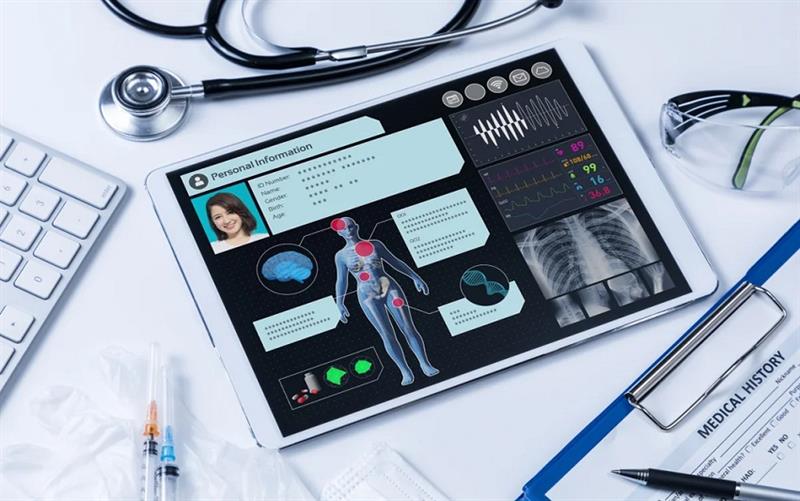
Healthcare is being revolutionized by the incorporation of cutting-edge software solutions, which make it more patient-centered, accessible, and efficient. These technologies, which range from EHRs to telemedicine platforms, are crucial for contemporary healthcare professionals that want to improve patient outcomes and their own services. Adopting these software solutions will be essential to maintaining leadership in innovation and providing the best possible treatment as the healthcare sector develops further.
Technological developments that improve overall efficiency, improve patient care, and streamline operations are driving a tremendous revolution in the healthcare industry. Software solutions created to satisfy the particular requirements of contemporary healthcare are at the heart of this change. Here is a look at the key software programs that are now transforming the healthcare industry.
1. Software for Practice Management
Simplifying Administrative Work
Software for practice administration is crucial to the smooth running of medical offices. Administrative chores including billing, scheduling appointments, and patient communication are all automated by it.
Important Elements
- Scheduling: Makes making appointments easier and lowers the number of no-shows.
- Claims and Billing: Automates insurance claims and billing procedures.
- Patient management: Keeps thorough communication logs and patient records.
Top Practice Management Systems
- Kareo: This practice management and invoicing platform is perfect for small businesses.
- Athenahealth: Offers robust analytics and reporting capabilities along with cloud-based solutions.
- NextGen Healthcare: Provides extensive patient management capabilities and workflows that are customized.
2. Solutions for Patient Engagement
Improving the Experience for Patients
Solutions for patient engagement give people the power to actively participate in their healthcare. They give patients access to resources for self-management, education, and communication, which improves patient outcomes and satisfaction.
Advantages of Involving Patients
- Better Interaction: Facilitates better communication between patients and providers.
- Enhanced Compliance: Promotes following treatment programs and receiving follow-up care.
- Empowerment: Gives patients access to resources for education and health knowledge.
Top Platforms for Patient Engagement
- Epic's MyChart: Provides a feature-rich patient interface with strong interaction capabilities.
- FollowMyHealth: Offers messaging, appointment booking, and health tracking features.
- Solutionreach: Well-known for its patient outreach and automated communication features.
3. CDSS, or clinical decision support systems
Encouraging Healthcare Professionals
Tools called Clinical Decision Support Systems (also known as CDSS) are intended to improve clinical decision-making. They give medical personnel patient-specific information and expertise based on evidence to enhance the delivery of care.
Benefits of CDSS
- Enhanced Precision: Minimizes errors in diagnosis and improves treatment strategy.
- Customized Care: Provides recommendations that are based on information about the patient.
- Enhanced Efficiency: Cuts down on pointless testing and streamlines clinical operations.
- Leading CDSS Solutions Current: Offers clinical information and tools for decision support based on evidence.
- IBM Watson Health: Provides insights into individualized care through artificial intelligence.
4. Platforms for Telemedicine
Increasing Healthcare Access
Access to healthcare services has increased significantly because to telemedicine platforms, particularly in rural areas. They lessen the need for in-person visits by enabling patients to consult with healthcare professionals via chat, phone conversations, or video conferencing.
- Convenience: Patients can obtain care from the comfort of their homes thanks to telemedicine.
- Cost-effective: Cuts down on time away from work and travel expenses.
- Timely Care: Makes follow-ups and consultations possible more quickly.
Best Solutions for Telemedicine
- Teladoc: Provides extensive virtual health services in a range of specializations.
- Amwell: Distinguished by its extensive provider network and easy-to-use UI.
- Doctor on Demand: Offers licensed doctors for on-demand video consultations.
5. Solutions for Health Information Exchange (HIE)
Improving Interoperability of Data
Solutions for health information exchange (HIE) make it possible for medical data to be securely transferred between various systems and institutions. By enhancing data interoperability, they guarantee that patient data is available when and where it is needed.
Advantages of High-Speed Ethernet
- Better Coordination: Promotes more provider-to-provider coordination of care.
- Decreased Redundancy: Reduces the amount of redundant procedures and testing.
- Improved Decision-Making: Offers extensive patient information to support well-informed choices.
Leading HIE Solutions
- A reliable HIE solution with a wealth of interoperability capabilities is provided by eClinicalWorks.
- Medicity: renowned for its scalable and safe HIE infrastructure.
- Intersystems: Offers an extensive collection of HIE technologies for smooth data transfer.
6. Software for Medical Billing and Coding:
Enhancing Revenue Cycle Management
Software for medical billing and coding simplifies the difficult process of charging for and classifying healthcare services. They optimize revenue cycle management by ensuring timely and correct reimbursement.
Important Elements
- Medical coding errors are decreased via automated coding.
- Claims management: Enables effective tracking and submission of claims.
- Analytics and reporting: Offers perceptions on the state of the finances.
Best Solutions for Medical Coding and Billing
- AdvancedMD: Provides sophisticated reporting tools along with extensive billing and coding options.
- DrChrono: Offers integrated EHR and billing systems customized for different specializations.
- NueMD: Well-known for its intuitive user interface and effective claims handling.
7. Systems for Electronic Health Records (EHR)
Improved Data Management and Patient Care
Systems for electronic health records, or EHRs, are now essential to contemporary healthcare. They give authorized users quick access to a secure digital copy of a patient's paper chart, complete with all the information they need. EHRs improve patient care through:
- Reducing inaccuracies in patient records is one way to improve accuracy.
- Streamlining Coordination: Enabling smooth exchange of patient data across various healthcare providers.
- Simplifying Workflow: Cutting back on documentation and administrative duties.
Top EHR Systems
- Epic Systems: Distinguished by its rich feature set and wide range of customization possibilities.
- Cerner: Provides robust analytics capabilities and an easy-to-use interface.
- Allscripts: Provides integrated solutions for both large hospitals and small practices.